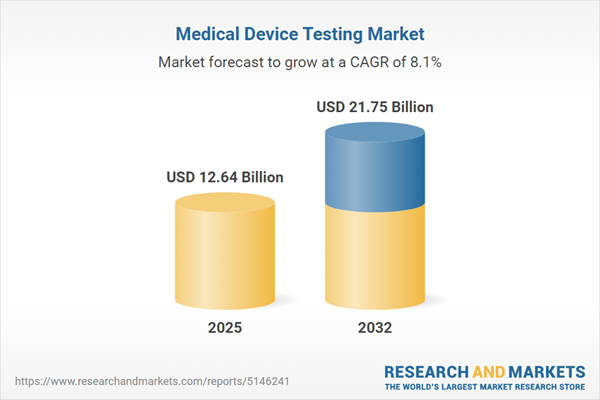Speak directly to the analyst to clarify any post sales queries you may have.
Senior executives in the medical device testing market operate in a landscape defined by regulatory complexity, rapid technological evolution, and increased scrutiny on quality standards. As industry demands intensify, proactive and precise market insights are vital in guiding strategic choices and strengthening operational platforms for sustainable growth.
Market Snapshot: Medical Device Testing Market Overview and Projections
The global medical device testing market is valued at USD 11.67 billion in 2024, with expansion projected to reach USD 12.64 billion in 2025 and USD 21.75 billion by 2032. The market demonstrates a compound annual growth rate of 8.08%. Trends driving this momentum include increasing healthcare needs, broad adoption of advanced testing tools, and rigorous international regulations. Growing expectations around safety and device efficiency mean organizations must continually advance their quality assurance processes. Enhanced process integration, digital modernization, and validation of protocols are helping companies navigate complex multinational requirements and adapt seamlessly to shifting compliance landscapes. Those that foster strong operational cohesion are better positioned to manage fluctuating standards and achieve streamlined market access.
Scope & Segmentation: Strategic Insights for the Medical Device Testing Market
This executive-focused report offers actionable guides for strategic planning, risk assessment, and regulatory compliance within the medical device testing sector by analyzing the following critical segments:
- Test Types: Biocompatibility, chemical, electrical, mechanical, performance, and sterility testing all support comprehensive device validation, inform risk assessments, and underpin documentation for compliance at each innovation stage.
- Technology Platforms: Leading analytical tools such as gas chromatography, HPLC, mass spectrometry, FTIR, NMR, UV-Vis spectroscopy, flow cytometry, and advanced microscopy enable precise data generation and interpretation. The adoption of automation and digitalized systems increases testing accuracy and maintains protocol integrity.
- End User Profiles: Stakeholders include academic institutions, contract laboratories, device manufacturers, specialized testing services, and research organizations, each with their unique compliance priorities and resource models shaping validation pathways.
- Device Categories: Cardiovascular, diagnostic imaging, dental, orthopedic, neurological, and ophthalmic devices present distinct risk considerations demanding tailored testing and approval processes aligned with specific international standards.
- Regional Coverage: The Americas, Europe, Middle East, Africa, and Asia-Pacific reflect varied regulatory regimes and adoption rates. Regional strategies for market entry and harmonization are essential for cross-border device approvals and enduring operational effectiveness.
Key Takeaways for Senior Decision-Makers
- Agility in regulatory compliance lessens the impact of industry shifts, supporting stability and future-proofing operations.
- Automated laboratory systems and robust quality management frameworks minimize manual workload, accelerate audit readiness, and address compliance issues efficiently.
- Integration of artificial intelligence into testing processes sharpens risk detection and informs more strategic resource allocation.
- Standardization and operational flexibility across locations ensure consistent outcomes and facilitate regulatory navigation.
- Strategic partnerships broaden regulatory perspectives, enhance insight flow, and foster steady multinational device management.
Tariff Impact: Navigating US Regulatory and Sourcing Challenges
Imminent US tariffs on medical device testing equipment, effective from 2025, prompt organizations to revise procurement tactics and bolster supply chain resilience. Leadership teams are responding by prioritizing regional sourcing, establishing contingency frameworks, and reinforcing collaborations with regulatory stakeholders. These measures collectively minimize disruption risks and uphold business continuity during periods of regulatory uncertainty and market flux.
Methodology & Data Sources
This report synthesizes insights from expert interviews, reviews of scientific literature, and patent analyses, with all key findings validated by independent subject matter specialists. This approach underpins both regulatory reliability and scientific rigor.
Why This Report Matters
- Empowers decision-makers to anticipate, adapt to, and leverage emerging technology within rapidly changing testing environments.
- Enhances the robustness of validation procedures and strengthens supply chain models for uninterrupted compliance across product lines.
- Delivers actionable, market-specific recommendations for integrating digital innovation and optimizing resource allocation across regions.
Conclusion
This analysis provides senior leaders with the tools to refine compliance strategies, drive technology integration, and optimize operational models as the medical device testing industry continues to evolve.
Additional Product Information:
- Purchase of this report includes 1 year online access with quarterly updates.
- This report can be updated on request. Please contact our Customer Experience team using the Ask a Question widget on our website.
Table of Contents
3. Executive Summary
4. Market Overview
7. Cumulative Impact of Artificial Intelligence 2025
Companies Mentioned
The companies profiled in this Medical Device Testing market report include:- Intertek Group plc
- Société Générale de Surveillance SA
- Bureau Veritas SA
- TÜV SÜD AG
- UL LLC
- DEKRA SE
- Eurofins Scientific SE
- BSI Group UK Limited
- NSF International
- CSA Group
Table Information
| Report Attribute | Details |
|---|---|
| No. of Pages | 186 |
| Published | October 2025 |
| Forecast Period | 2025 - 2032 |
| Estimated Market Value ( USD | $ 12.64 Billion |
| Forecasted Market Value ( USD | $ 21.75 Billion |
| Compound Annual Growth Rate | 8.0% |
| Regions Covered | Global |
| No. of Companies Mentioned | 11 |









